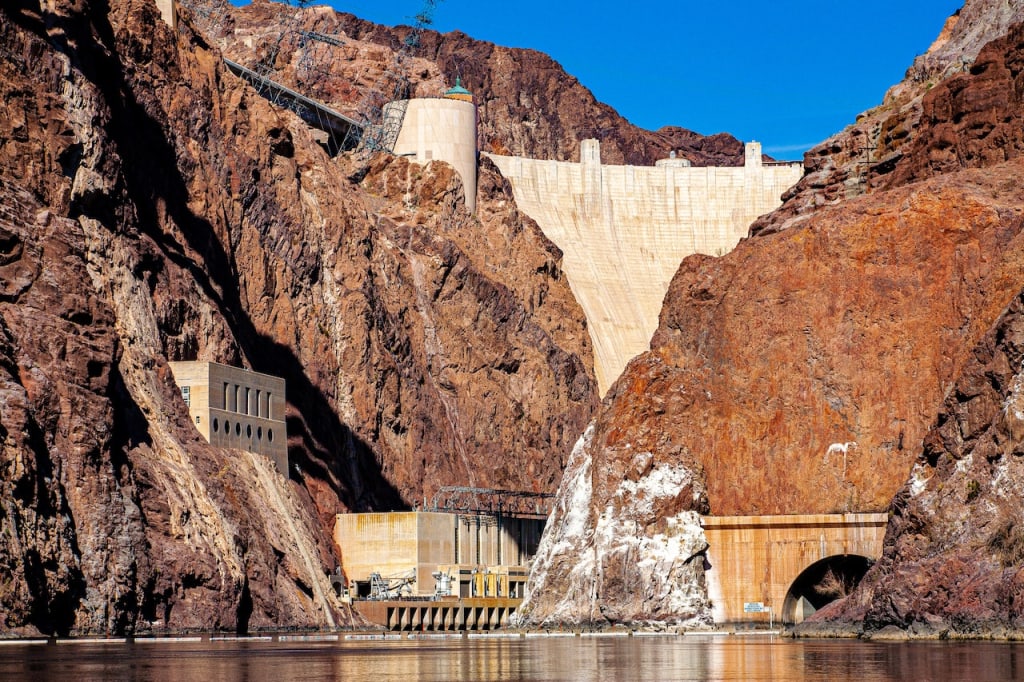The Hoover Dam
Triumphs and Tragedies in the Arid Southwest

High above Nevada's Black Canyon, a daring group of men descended the cliff face, their mission focused and perilous. Suddenly, disaster struck as a man stumbled over the canyon rim, hurtling past his comrades too swiftly to be rescued. But in a remarkable display of bravery, another climber swung out from the rocks, swooping down to save his imperiled companion. With the engineer safely retrieved, the hero returned to his work, just another day in the construction of the Hoover Dam.
In the early 20th century, while the United States had expanded from coast to coast, the arid cities of the southwest struggled with limited water sources. Despite the diversion of the Colorado River into canals, its unpredictable flow and frequent floods hampered reliable agricultural use. Additionally, the region's growing cities and industries demanded an ever-increasing supply of energy. In 1922, the Bureau of Reclamation embarked on an ambitious project to address all these challenges simultaneously by constructing a monumental hydroelectric dam.
Securing water rights for the project necessitated unprecedented collaboration among the seven states along the river. Once local governments reached an agreement, the Bureau identified Black Canyon's narrow gorge as the ideal location for an arch-gravity dam. This innovative design curved upstream, utilizing the force of the rushing water to stabilize the structure against the canyon walls. While arch dams had existed since ancient times, the scale of this endeavor was unparalleled. The final dam would span 221 by 379 meters, an awe-inspiring feat.
Constructing such a colossal dam demanded an enormous workforce. When the Great Depression struck just a year after the project's approval, thousands of desperate families flocked to the site in search of employment. The earliest arrivals settled in a rudimentary encampment known as Ragtown. Inadequate infrastructure, scarce supplies, and harsh weather conditions resulted in several tragic deaths from heatstroke. To provide better living conditions for the workers, the government planned and built Boulder City, a thriving settlement complete with various amenities, including a state-of-the-art hospital.
Before dam construction could commence, the entire river had to be redirected. Workers toiled tirelessly to blast through the canyon walls, creating diversion tunnels measuring 17 meters in height and nearly 5 kilometers in combined length. These tunnels were capable of diverting approximately 5,600 cubic meters of water per second. Despite the grueling conditions, numerous workers persevered, although many succumbed to the blistering heat.
By the fall of 1932, the river had been successfully rerouted, marking a significant milestone. However, the most treacherous phase still lay ahead. Over a million cubic meters of loose rock had to be painstakingly cleared from the canyon walls. Highly skilled high scalers descended the cliffs on ropes, employing jackhammers and dynamite to remove the rubble. From circus acrobats and former sailors to local Apache, these daring individuals performed some of the most dangerous and mesmerizing work on the construction site.
Once the walls were cleared, the time had come to build the dam itself. Pouring over 6.6 million tons of concrete—a quantity sufficient to pave a road across the entire United States—was no small feat. To expedite the cooling and hardening process, concrete was poured in interlocking blocks of varying sizes, each containing steel pipes circulating cold water. By 1935, the majority of the structure had been completed, an impressive achievement two years ahead of schedule.
On February 1st, the diversion tunnels were opened, allowing the dam's reservoir to fill. Capable of holding twice the annual flow of the Colorado River, the reservoir marked a significant milestone. Upon completion, the Hoover Dam stood as the tallest manmade structure in the world, a testament to human ingenuity and perseverance. However, the rapid pace of construction came at a heavy price. Over 100 lives were lost during the project, a somber reminder of the sacrifices made. The creation of the reservoir also resulted in the submergence of communities like St. Thomas and had a profound impact on the Colorado River ecosystem.
Today, the Hoover Dam stands as a testament to human achievement, generating over 4 billion kilowatt-hours of electricity annually, providing power for more than 1.3 million people. However, the consequences of its construction continue to cast a shadow over this monumental structure. The triumphs and tragedies of the Hoover Dam serve as a reminder of the complexities and enduring impact of large-scale engineering projects.
Henrik Leandro
About the Creator
Henrik Leandro Laukholm Solli
Free thinker, traveler and humanist <3






Comments
There are no comments for this story
Be the first to respond and start the conversation.